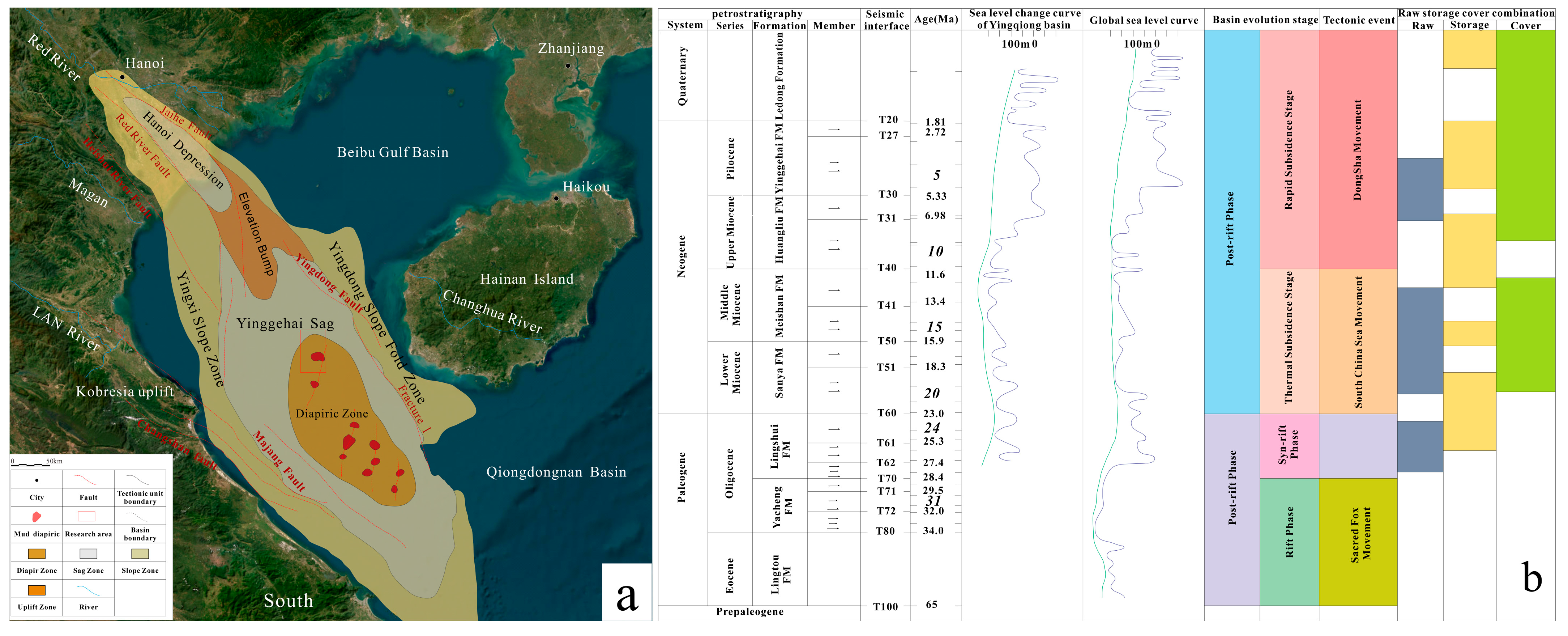Characterization and Numerical Modeling of Shallow Marine Turbidite Depositional Systems: A Case Study from the Second Member of the Yinggehai Formation, X Gas Field, Yinggehai Basin
Abstract
1. Introduction
2. Regional Geological Background
3. Materials and Methods
3.1. Core and Grain Size Characterization Analysis
3.2. Well Log Facies and Seismic Facies Analysis
- Channel: Formed under strong hydrodynamic conditions, the channel is the result of erosion by turbidity currents, creating a negative topography that is later filled with clastic material. The lithology is relatively homogeneous. In the natural gamma log, it exhibits high-amplitude, micro-toothed box-shaped curves, with sharp contact at both the top and bottom. On seismic data, it appears as a medium to strong amplitude, mid-frequency reflection (Figure 4), with the profile displaying a “U” shape, and internal reflections showing a filling characteristic (Figure 4).
- Mound body: During turbidity current transport, the hydrodynamic conditions gradually weaken, and the channel scale decreases. The sediment at the channel’s end continues to spill out, forming mound-shaped sand bodies [33]. On the natural gamma curve, this shows a high-amplitude, toothed + funnel-shaped combination, with gradual contact at both the top and bottom. On seismic data, it appears as medium to weak amplitude, mid-frequency reflections (Figure 3), with the profile displaying a “flat base and convex top” hill-like shape. On the plane, it appears mound-shaped. Single mound bodies are difficult to identify in the study area, and more commonly, multi-phase mound bodies are laterally connected and vertically superimposed to form mound body complexes, which are reflected in seismic profiles as large-scale, relatively thick sheet-like structures that extend from the center to the ends and gradually taper off (Figure 4).
- Shelf mud: Formed under relatively weak hydrodynamic conditions, fine-grained suspended material slowly settles and forms mud deposits. The natural gamma curve shows low-amplitude, micro-toothed box-shaped patterns, with sharp contact at both the top and bottom. Seismically, it exhibits medium to weak amplitude, high-frequency, sub-parallel reflection characteristics (Figure 3), with a sheet-like shape. However, the seismic reflection of shelf mud differs noticeably from the mound body complex in terms of amplitude and frequency, especially when mound bodies stack to form sheet-like reflections (Figure 4).
- Channel-side accumulation: During lateral migration of the channel, hydrodynamic conditions change, with the channel-side accumulation developing at the concave bank of the channel where hydrodynamics gradually weaken. The natural gamma curve shows a combination of high-amplitude, toothed box-shaped patterns + funnel-shaped features, with sharp contact at the top and gradual contact at the bottom. Seismically, it appears as medium to weak amplitude (Figure 3), with a filling shape and a shingled configuration (Figure 4).
3.3. Establishment of Sedimentary Numerical Simulation Model
- SA is the area (in km2),
- TS is the subsidence of the basement (in meters),
- AT is the accommodation space (in km3).
3.4. Sedimentary Model Establishment
- Provenance Accumulation Zone: Sediment from the nearshore source is continually deposited along the shelf edge, forming a provenance accumulation zone.
- Turbidite Channel Zone: In this zone, the sediments become unstable under certain triggers and slide down the slope, forming block flow deposits. If these block deposits are transformed into turbidity currents, the resulting channel is referred to as a turbidite channel [36,37,38,39,40,41]. Turbidite channels are key geomorphic units connecting the shelf, slope, and deep-sea basin, serving as crucial sites for transporting and depositing terrestrial clastic sediments into the deep sea [42]. The region dominated by these channels is called the transition zone.
- Distal Mound Zone: The channel typically extends to the basin floor, where the turbidity current energy diminishes, flow velocity decreases, and mound-like deposits form at the distal end. These three regions exhibit distinct geological features, which are crucial for the identification of turbidity current systems and the exploration and development of oil and gas resources [38].
- The provenance from the northwest Red River region is obstructed by the sedimentary slope break, forming an accumulation zone.
- Sediments become unstable and slide down the continental slope, forming turbidite channels.
- Due to high areas formed by the basement uplift in the southern part of the study area, turbidity current velocity slows down, and mound-like deposits (mounds) form.
- High-energy turbidity currents bypass the basement high areas, laterally migrating to form channel-side accumulation bodies, and continue to move downward.
4. Results
4.1. Petrological Characteristics
- Jump-Suspension Two-Segment Type:
- 2.
- Wide, Gentle Arch Type:
4.2. Shallow Marine Turbidity Current Sedimentary Evolution Process
4.3. Shallow Marine Turbidity Current Sedimentary Model
4.3.1. Control Factor Analysis
4.3.2. Sedimentary Numerical Simulation Results Analysis
- A.
- 2.40–3.00 Ma: During this period, early mound bodies formed in the central and northern parts of the study area, as well as in the southwest, but they were isolated with considerable distance between them. The channels had developed to some extent, but deposition was not significant, and no lateral migration was observed. The turbidity currents bypassed the mound bodies, leading to the formation of elevated areas, resulting in bending. The sand bodies were concentrated at the base and middle parts of the mound bodies, while the front end was rich in mud.
- B.
- 3.00–2.88 Ma: With an increase in sediment supply, sediment overflow occurred in some branch channels, leading to the formation of late-stage mound bodies. The areas of the early mound bodies continued to grow, and the distance between them decreased, though they were still isolated. The main channel deposition became more prominent, and lateral migration began to appear in the southern part. The sand body area expanded, while the ends of both the channels and mound bodies became increasingly rich in mud.
- C.
- 2.88–2.40 Ma: The extent of the mound bodies continued to expand, with lateral connections and vertical superimposition occurring between the mound bodies. This meant that isolated mound bodies connected laterally, and late-stage mound bodies covered earlier mound bodies. In the central part of the study area, a large mound body complex was formed, presenting a sheet-like shape, thinning gradually in the direction of the short axis of the model. The channel system widened overall, and the southern lateral migration ceased to increase significantly, with channel-side accumulation phenomena becoming more pronounced.
5. Conclusions
- (1)
- The shallow marine turbidity current sedimentary system of the Yinggehai Formation Ying’er Member in the X Gas Field develops four sedimentary units: channel, channel-side accumulation, mound body, and shelf mud. These units show distinct differences in core characteristics, grain size features, well log facies, and seismic facies.
- (2)
- The turbidity current energy evolved from weak to strong and then back to weak over time. In the X Gas Field, this resulted in a vertical lithologic sequence of mudstone, sandstone, and mudstone. Laterally, in the early stage, isolated mound bodies were deposited in the central and southwestern parts of the study area. Channels developed along the long axis direction, with relatively small scale and no lateral migration. In the middle to late stages, branch channels in the northwest evolved into mound bodies, with isolated mound bodies starting to connect laterally and stack vertically. A larger mound body complex developed in the central part of the study area, the main channel scale expanded, and lateral migration occurred in the southern part, forming channel-side accumulation bodies.
- (3)
- The shallow marine turbidity current sedimentary model in the X Gas Field is mainly controlled by relative sea level fluctuations, changes in sediment supply, and the evolution of the sedimentary basement (paleogeomorphology). During the deposition of the Ying’er Member, the sea level exhibited an overall fluctuating downward trend. The continuously increasing turbidity current carried terrestrial clastic material from the northwest Red River provenance zone down the continental slope, where sedimentation was controlled by the slope break and blocked by high areas formed by basement uplift. This process resulted in the formation of turbidity current sedimentary systems on the upper shelf.
- (4)
- Using sedimentary numerical simulation techniques, and by controlling the sea level, sediment supply, and sedimentary basement (paleogeomorphology), the evolution of the shallow marine turbidity current system in the X Gas Field was reconstructed. The simulation results show a high degree of correlation with the actual geological data and are consistent with existing geological understanding.
Author Contributions
Funding
Data Availability Statement
Conflicts of Interest
References
- Galloway, W.E.; Hobday, D.K. Terrigenous Clastic Depositional Systems; Springer: Berlin/Heidelberg, Germany, 1996. [Google Scholar]
- Zhao, C.; Zhu, X. Sedimentary Petrology, 3rd ed.; Petroleum Industry Press: Beijing, China, 2001; p. 407. [Google Scholar]
- Tokuhashi, S. Shallow-marine turbiditic sandstones juxtaposed with deep-marine ones at the eastern margin of the Niigata Neogene backarc basin, central Japan. Sediment. Geol. 1996, 104, 99–116. [Google Scholar] [CrossRef]
- Hampson, G.J.; Procter, E.J.; Kelly, C. Controls On Isolated Shallow-Marine Sandstone Deposition and Shelf Construction: Late Cretaceous Western Interior Seaway, Northern Utah and Colorado, U.S.A. 2008. Available online: https://pubs.geoscienceworld.org/sepm/books/edited-volume/1383/chapter-abstract/10815784/Controls-on-Isolated-Shallow-Marine-Sandstone?redirectedFrom=fulltext (accessed on 28 April 2025).
- Pattison, S.A.J. Storm-influenced prodelta turbidite complex in the lower Kenilworth Member at Hatch Mesa, Book Cliffs, Utah, U.S.A.; implications for shallow marine facies models. J. Sediment. Res. 2005, 75, 420–439. [Google Scholar] [CrossRef]
- Huang, Y.; Tan, X.; Liu, E.; Wang, J.; Wang, J. Sedimentary processes of shallow-marine turbidite fans: An example from the Huangliu Formation in the Yinggehai Basin, South China Sea. Mar. Pet. Geol. 2021, 132, 105191. [Google Scholar] [CrossRef]
- Huang, Y.; Yao, G.; Zhou, F. Provenance Analysis of Shallow Marine Gravity Flow Sand Bodies in the Huangliu Formation of the Yinggehai Basin and Its Petroleum Geological Significance. Earth Sci. 2016, 41, 1526–1538. [Google Scholar]
- Wang, H.; Chen, S.; Jiang, S. Can large gravity flow deposits accumulate and develop in a shallow sea background? Earth Sci. 2022, 47, 3867–3868. [Google Scholar]
- Põldsaar, K.; Ainsaar, L.; Nemliher, R.; Tinn, O.; Stinkulis, G. A siliciclastic shallow-marine turbidite on the carbonate shelf of the Ordovician Baltoscandian palaeobasin. Est. J. Earth Sci. 2019, 68, 1–14. [Google Scholar]
- Fenton, M.W.; Wilson, C.J.L. Shallow-water turbidites: An example from the Mallacoota Beds, Australia. Sediment. Geol. 1985, 45, 231–260. [Google Scholar] [CrossRef]
- Nelson, C.H. Modern Shallow-water Graded Sand Layers from Storm Surges, Bering Shelf: A Mimic of Bouma Sequences and Turbidite Systems. J. Sediment. Res. 1982, 52, 537–545. [Google Scholar]
- Winn, R.D.; Bishop, M.; Gardner, P.S. Lewis Shale, South-Central Wyoming: Shelf, Delta Front, and Turbidite Sedimentation; Wyoming Geological Association: Casper, WY, USA, 1985. [Google Scholar]
- Went, D.J. Alluvial fan, braided river and shallow-marine turbidity current deposits in the Port Lazo and Roche Jagu formations, Northern Brittany: Relationships to andesite emplacements and implications for age of the Plourivo-Plouézec Group. Geol. Mag. 2017, 154, 1037–1060. [Google Scholar] [CrossRef]
- Okay, S. Morphological and stratigraphic investigation of the holocene subaqueous shelf fan, north of istanbul strait in the black sea. Turk. J. Earth Sci. 2011, 20, 287–305. [Google Scholar]
- Ge, Z.; Xu, H. Hydrodynamic and sedimentary responses of turbidity currents to complex tectonic landforms. J. Palaeogeogr. 2023, 25, 1090–1117. [Google Scholar]
- Yu, J.; Yang, T.; Tian, J.; Cai, L.; Ren, Q.; Guo, W. Several basic sedimentological problems and research prospects in deep water gravity flow sedimentary oil and gas exploration. J. Palaeogeogr. 2023, 25, 1299–1314. [Google Scholar]
- Wu, J.; Wang, Y.; Wang, H.; Li, H.; Peng, X.; Qiu, Y.; Li, D. Research progress on the interaction between gravity flow and underflow in deep water. Geol. Rev. 2012, 58, 1110–1120. [Google Scholar]
- Wang, H.; Chen, S.; Liu, E.; He, J.; Gan, H.; Meng, F.; Nian, W. Sedimentary characteristics and provenance system of typical gravity flow in Yingqiong Basin, northern South China Sea. Bull. Geol. Sci. Technol. 2022, 41, 5–18. [Google Scholar]
- Zhou, W.; Zhang, H.; Yang, Z.; Wang, Y.; Hu, W.; Mo, F.; Wang, Y. Sedimentary facies of sandy clastic flow in Dongfang Gas Field, Yinggehai Basin. Sci. Technol. Eng. 2022, 22, 15062–15073. [Google Scholar]
- Hui, Z. Study on Reservoir Configuration of High Curvature Gravity Flow Channel in the Second Member of Yinggehai Formation, Dongfang Gas Field. Master’s Thesis, Northwest University, Xi’an, China, 2021. [Google Scholar]
- Zhou, W.; Zhang, L.; Ma, Y.; Yang, K.; Guan, L.; Gao, Y.; Chen, S. Study on source-channel-sink of the second Member of the Upper Holocene Ying Formation in Dongfang 1-1 Gas field, Yinggehai Basin. J. Northwest Univ. (Nat. Sci. Ed.) 2021, 51, 459–469. [Google Scholar]
- Chen, S. Study on Sedimentary Facies Types and Development Laws of the Second Member of Yinghe Formation, Dongfang Gas Field, Yinggehai Basin. Master’s Thesis, Northwest University, Xi’an, China, 2020. [Google Scholar]
- Yue, S.-F.; Zhang, H.; Wang, Q.-S.; Cheng, T.; Li, J.; Chen, X.-W.; Qin, S. New sedimentary understanding of the second member of Yinggehai Formation, Dongfang A Gas field, Yinggehai Basin: Submarine fan turbidite sheet sand. Mar. Pet. Geol. 2017, 22, 11–18. [Google Scholar]
- Wang, C.; Liang, X.; Fu, J.; Jiang, Y.; Dong, C.; Yu, S.; Xiang, J.; Zhou, Y.; Wen, S. U-Pb dating of detrital zircon from the second member of Yinggehai Formation, Yinggehai Basin and its provenance significance. Geol. Rev. 2015, 61, 716–717. [Google Scholar]
- Feng, C.; Huang, Z.; Tong, C.; Zhu, J.; Fan, H.; Liu, J. Comprehensive evaluation of mudstone cap closure in the second member of Yinggehai Formation, Yinggehai Basin. J. Earth Sci. Environ. 2011, 33, 373–377. [Google Scholar]
- Ren, J.; Lei, C. Tectono-stratigraphic framework of Yinggehai-Qiongdongnan Basin and dynamic deformation zoning of the South China Sea. Chin. J. Geophys. 2011, 54, 3303–3314. [Google Scholar]
- Sun, X.; Ren, J. The dynamic mechanism of formation and evolution of Yinggehai Basin. Mar. Geol. Quat. Geol. 2003, 45–50. [Google Scholar] [CrossRef]
- Yue, S.; Zhang, H.; Yang, Z.; Zhou, W.; Tan, L.; Xue, G. Genetic mechanism analysis of “lateral accumulation” complex of Yinggehai Formation under shallow sea background of Dongfang A gas field. Pet. Geol. Recovery Effic. 2018, 25, 32–37. [Google Scholar]
- Li, L.; Zhang, P.; Zou, Y.; Ping, T.; Zhuang, Y.; Wang, X. Shallow sea seismic sedimentary facies in Dongfang X area, Yinggehai Basin. Mar. Geol. Front. 2019, 35, 31–39. [Google Scholar]
- Xie, J.; Zhu, Y.; Li, X.; Mai, W.; Zhao, P. Cenozoic sea level change in Yingqiong Basin, northern continental shelf, South China Sea. Mar. Orig. Pet. Geol. 2012, 17, 49–58. [Google Scholar]
- Xiao, K.; Tong, H.-M.; Yang, D.-H.; Li, X.; Fan, C.; Zhang, H.; Huang, L. Restoration of paleotectonic landform since Neogene in Yinggehai Basin. Pet. Geol. Exp. 2020, 42, 215–222. [Google Scholar]
- Farouk, S.; Saada, S.A.; Fagelnour, M.S.; Arafat, M. Petrophysical and gas chromatographic analysis integration for hydrocarbon identifications in Cretaceous reservoirs, Azhar Field, Beni Suef Basin, Egypt. Egypt. J. Pet. 2024, 33, 7. [Google Scholar] [CrossRef]
- Mulder, T.; Etienne, S.; Mulder, T. Lobes in deep-sea turbidite systems; state of the art. Sediment. Geol. 2010, 229, 75–80. [Google Scholar] [CrossRef]
- Farouk, S.; Ahmed Saada, S.; Arafat, M.; Al-Kahtany, K.; Gentzis, T.; Zaky, A.S.; Jovane, L. Thermal maturity and gas generation in Upper Cretaceous formations of the Beni Suef Basin, Egypt: Insights from stable carbon isotopes and geochemical analysis of the Azhar-E1X well. Front. Earth Sci. 2025, 13, 1552662. [Google Scholar] [CrossRef]
- Farouk, S.; Saada, S.A.; Fagelnour, M.; Tawfik, A.Y.; Arafat, M.; El-Kahtany, K. Geochemical evaluation and basin modelling of the Cretaceous succession in the Azhar Oil Field, West Beni Suef Basin, Egypt. Geol. J. 2024, 59, 1949–1967. [Google Scholar] [CrossRef]
- Rao, M.; Zhong, J.; Zhao, Z. Review and Prospect of Turbidity Current Sedimentation Research. Coal Geol. Explor. 2004, 32, 1–5. [Google Scholar]
- Posamentier, H.W.; Kolla, V.; Liu, H.Q. Review of Deep-Water Turbidity Current Sedimentation. Acta Sedimentol. Sin. 2019, 37, 879–903. [Google Scholar]
- Lowe, D.R. Sediment gravity flows; II, Depositional models with special reference to the deposits of high-density turbidity currents. J. Sediment. Petrol. 1982, 52, 279–297. [Google Scholar]
- Lowe, D.R.; Doyle, L.J.; Pilkey, O.H. Sediment gravity flows; their classification and some problems of application to natural flows and deposits. Spec. Publ.-Soc. Econ. Paleontol. Mineral. 1979, 75–82. [Google Scholar] [CrossRef]
- Stetson, H.C. The Sediments of the Continental Shelf off the Eastern Coast of the United States. 1938. Available online: https://darchive.mblwhoilibrary.org/handle/1912/1091 (accessed on 19 May 2025).
- Wang, P. Deep sea sediments and Earth system. Mar. Geol. Quat. Geol. 2009, 29, 1–11. [Google Scholar]
- Nagel, S.; Granjeon, D.; Willett, S.; Lin, A.; Castelltort, S. Stratigraphic modeling of the Western Taiwan foreland basin: Sediment flux from a growing mountain range and tectonic implications. Mar. Pet. Geol. 2018, 96, 331–347. [Google Scholar] [CrossRef]
- He, W.-J.; Xie, J.-Y.; Liu, X.-Y.; Li, S. Study on foraminifera biostratigraphy and sedimentary environment in well DF1-1-11, Yinggehai Basin. J. Stratigr. 2011, 35, 81–87. [Google Scholar]
- Jiang, Z. Sedimentology, 2nd ed.; Petroleum Industry Press: Beijing, China, 2010; p. 424. [Google Scholar]
- Muto, T.; Steel, R.J. Principles of regression and transgression; the nature of the interplay between accommodation and sediment supply. J. Sediment. Res. 1997, 67, 994–1000. [Google Scholar] [CrossRef]
- Cao, L.; Jiang, T.; Shao, L.; Sun, H. Middle Mioene-Pliocene Provenance Evolution in Yinggehai Basin, Northwest South China Sea. In Proceedings of the 13th National Conference on Paleogeography and Sedimentology; Thirteenth National Organizing Committee on Paleogeography and Sedimentology: Beijing, China, 2014. [Google Scholar]
- Farouk, S.; Fagelnour, M.; Zaky, A.S.; Arafat, M.; Salama, A.; Al-Kahtany, K.; Gentzis, T.; Jovane, L. Petroleum system evaluation: Hydrocarbon potential and basin dynamics in Abu Darag Sub-Basin, Northern Gulf of Suez (Egypt). Minerals 2024, 14, 1154. [Google Scholar] [CrossRef]
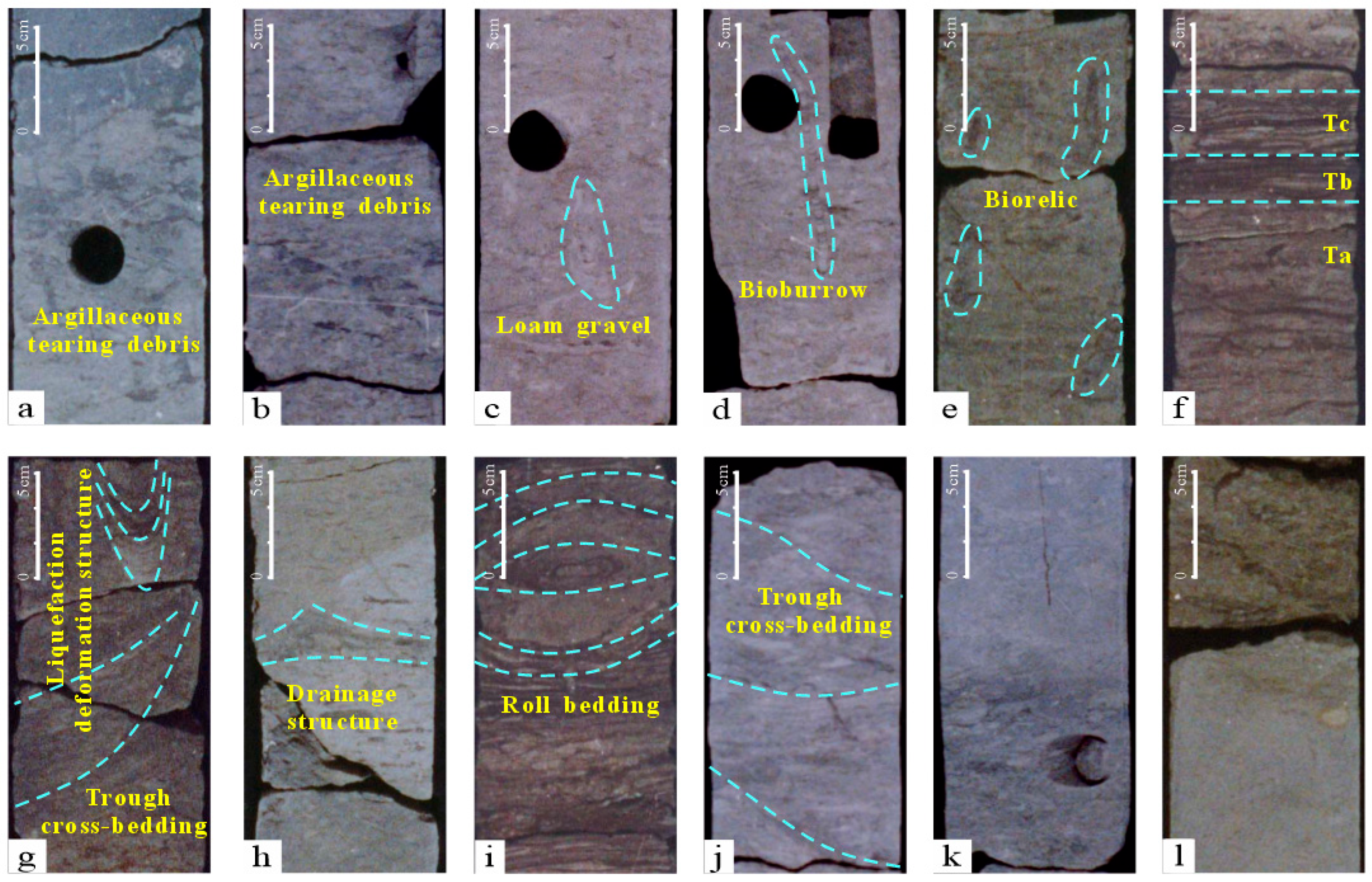
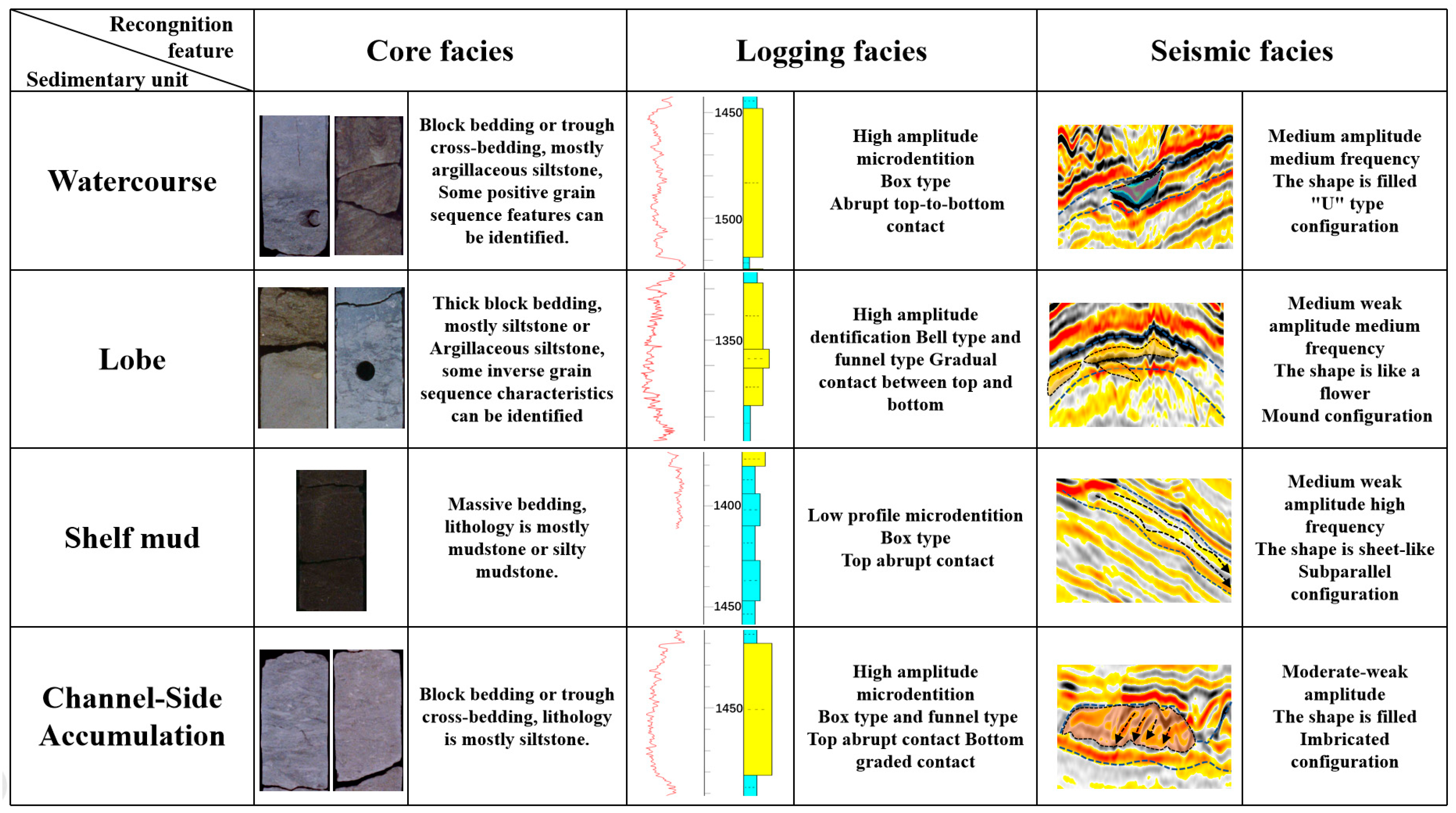
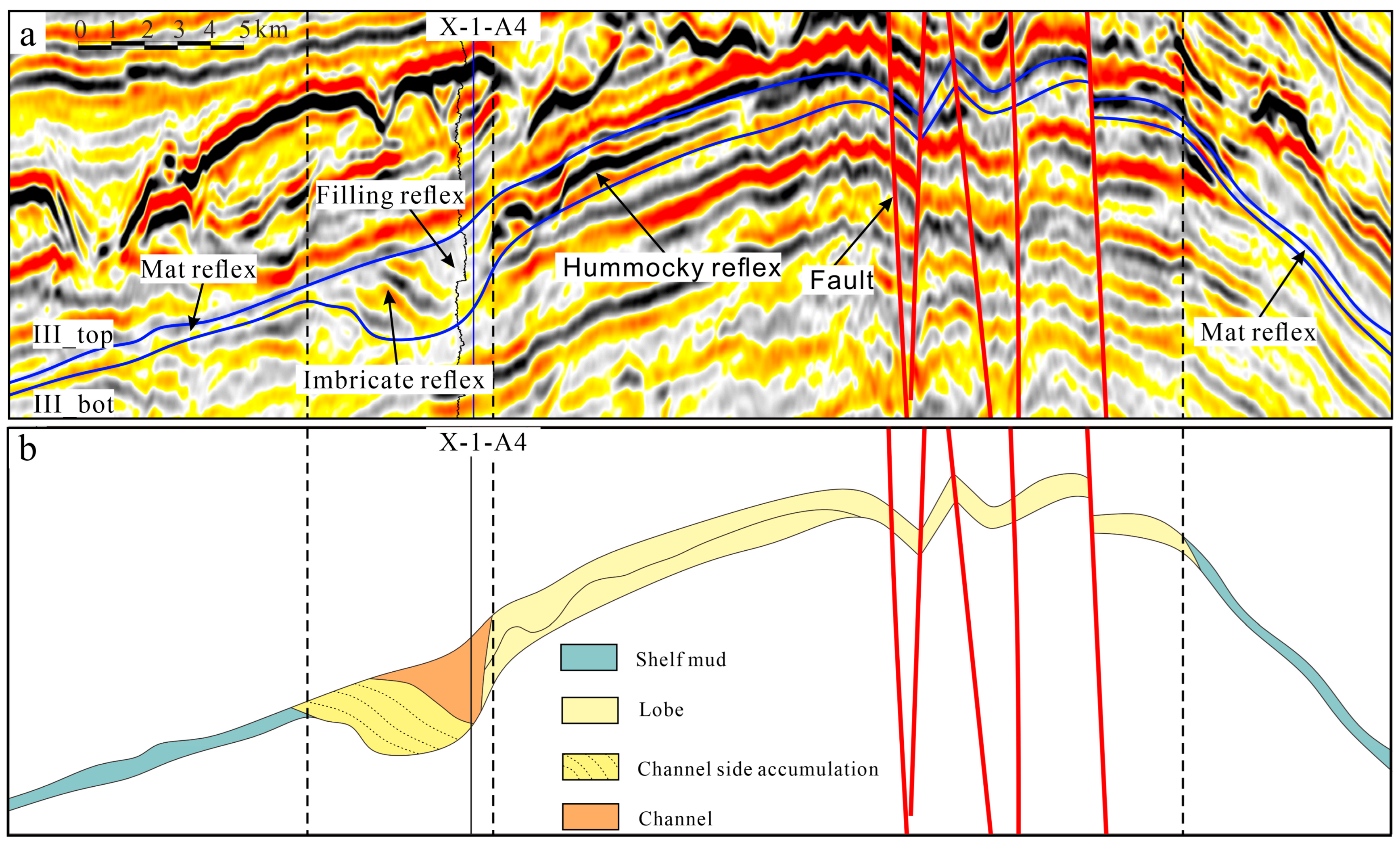
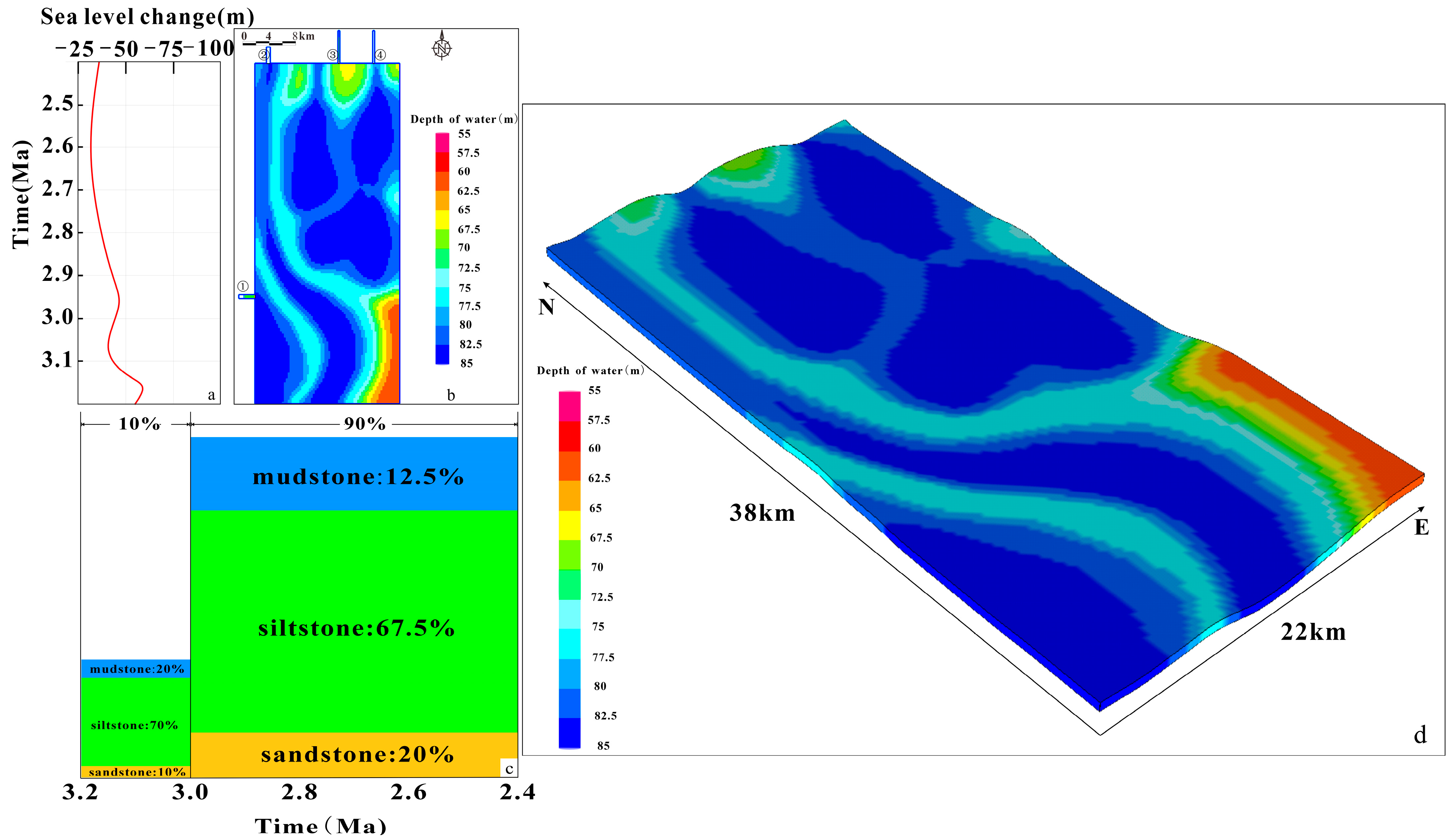
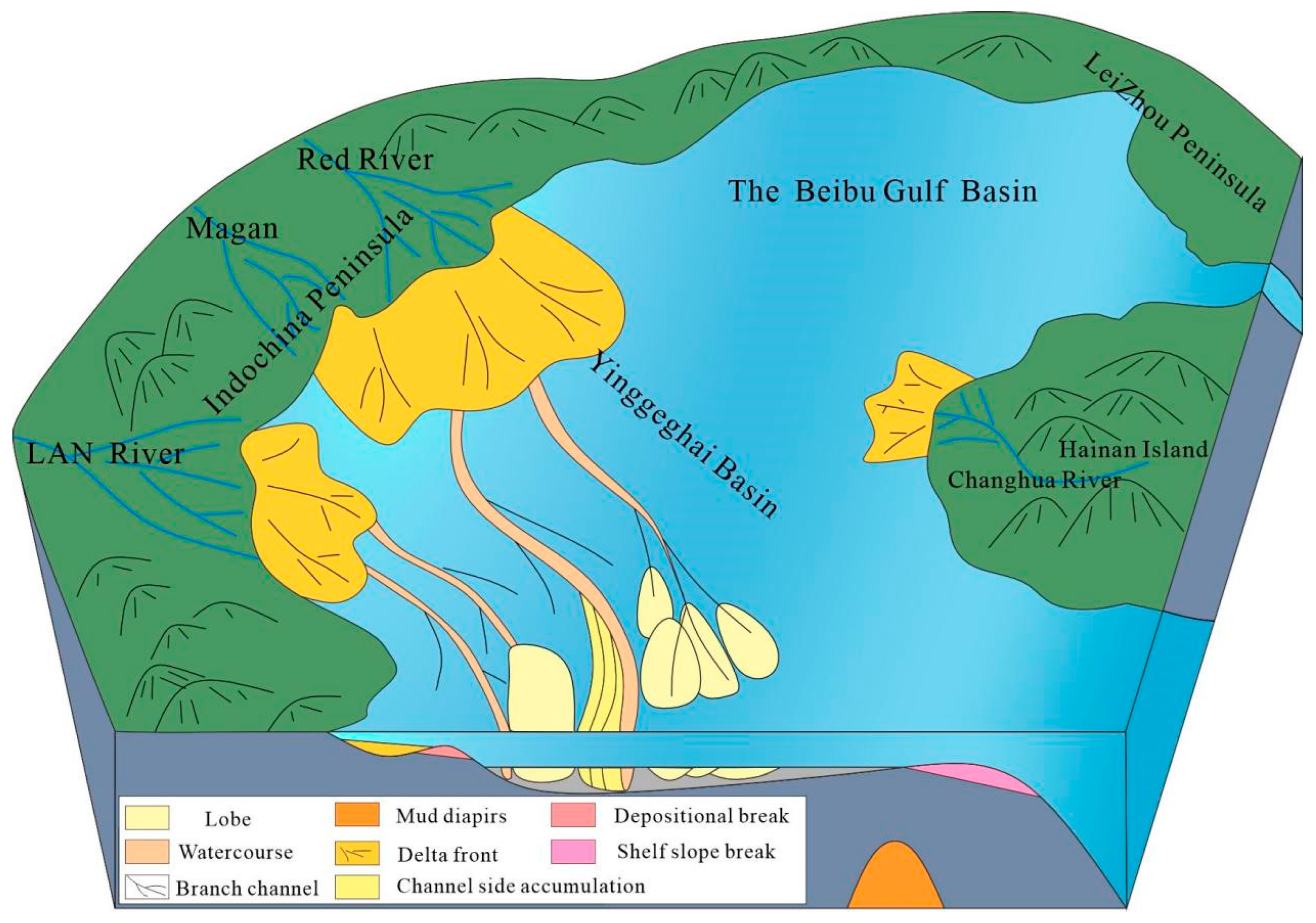
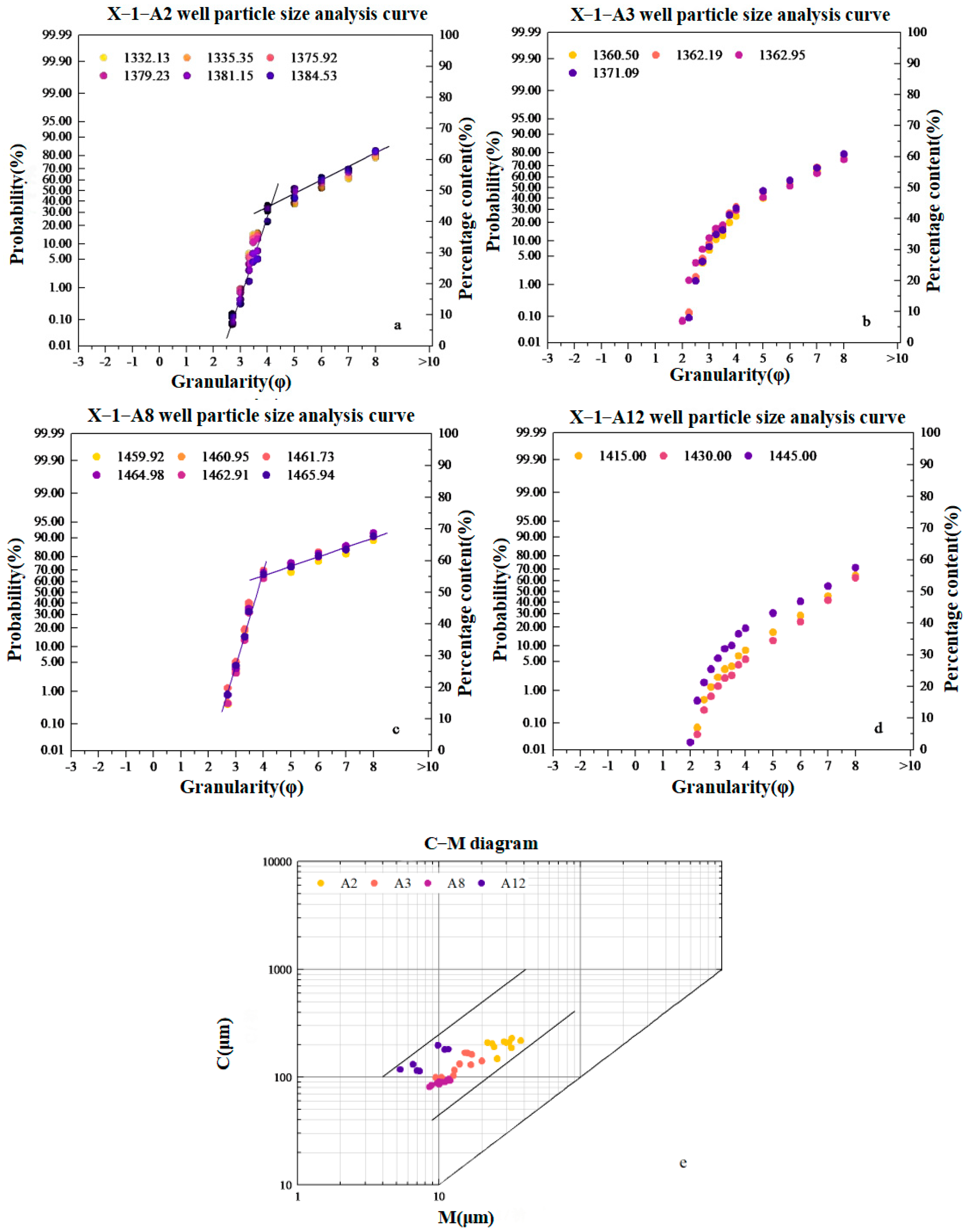
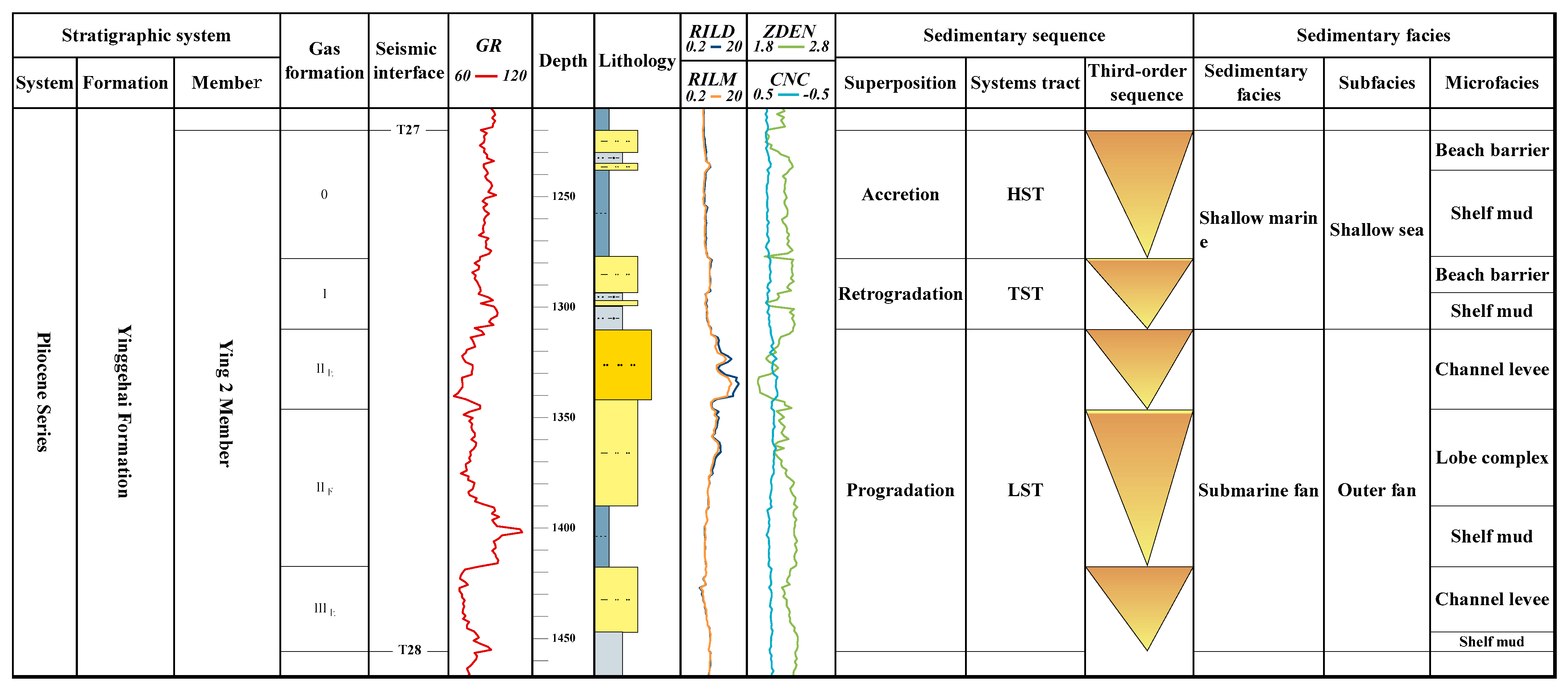
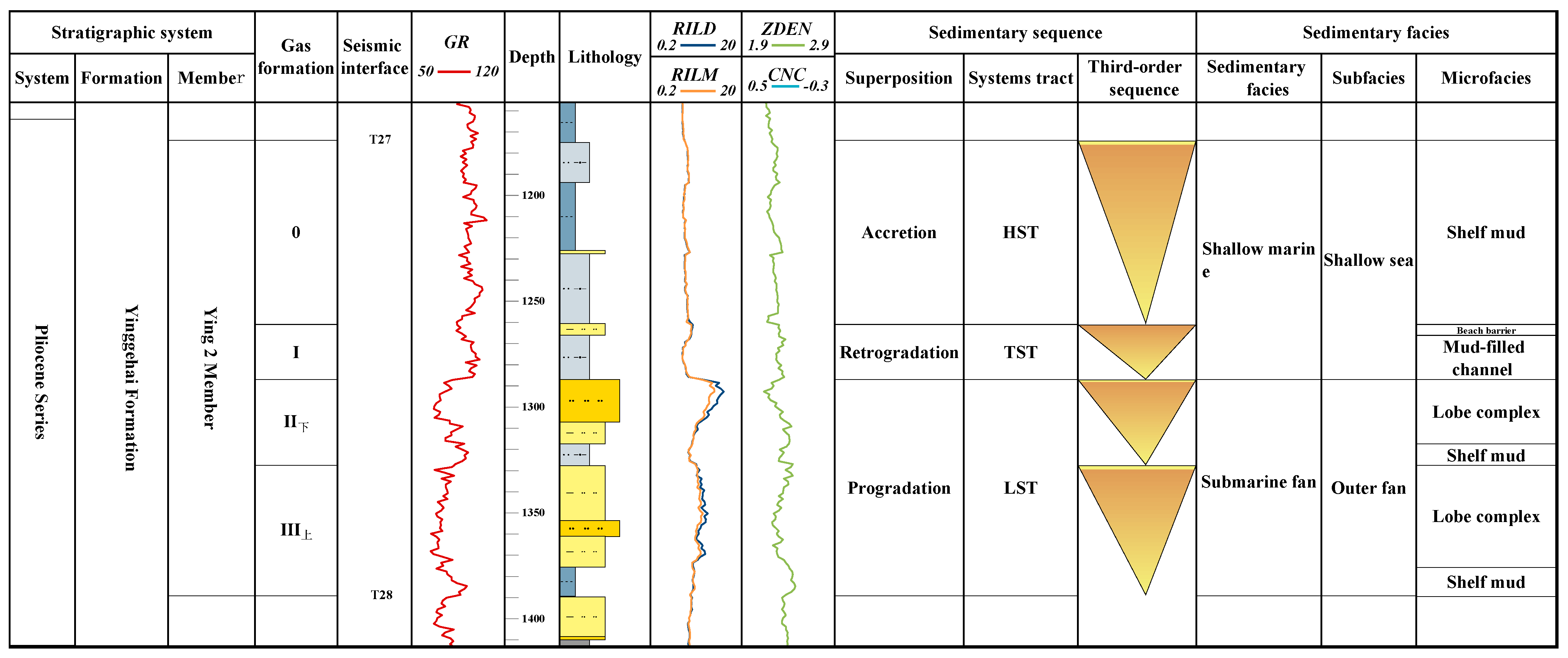

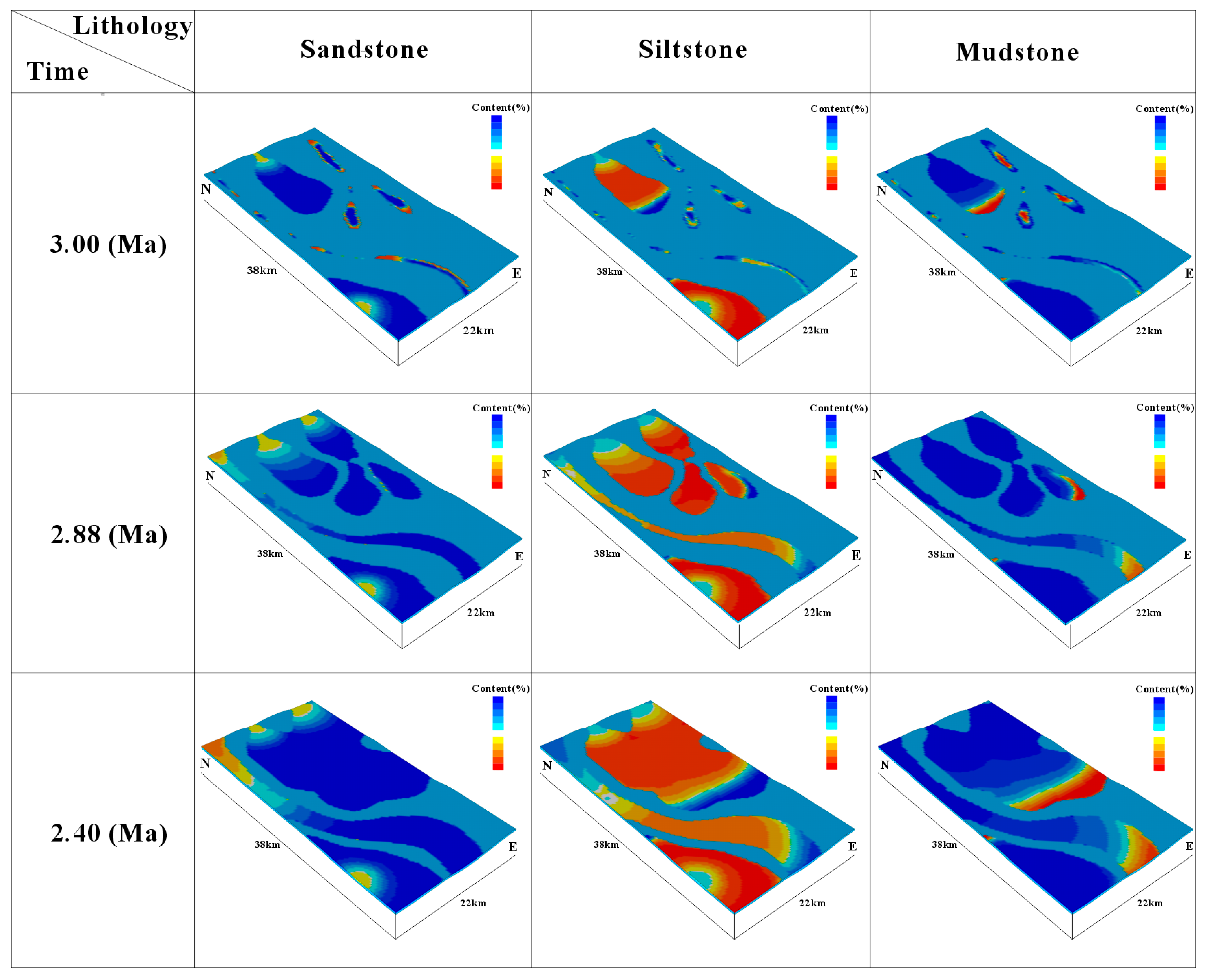
| Lithology | Sandstone | Siltstone | Mudstone |
|---|---|---|---|
| Granularity (mm) | 0.138 | 0.012 | 0.002 |
| Handling speed (km/ka) | 0.27 | 0.78 | 4.7 |
Disclaimer/Publisher’s Note: The statements, opinions and data contained in all publications are solely those of the individual author(s) and contributor(s) and not of MDPI and/or the editor(s). MDPI and/or the editor(s) disclaim responsibility for any injury to people or property resulting from any ideas, methods, instructions or products referred to in the content. |
© 2025 by the authors. Licensee MDPI, Basel, Switzerland. This article is an open access article distributed under the terms and conditions of the Creative Commons Attribution (CC BY) license (https://creativecommons.org/licenses/by/4.0/).
Share and Cite
Wei, J.; Li, L.; Xu, Y.; Xue, G.; Zhang, Z.; Zhang, G. Characterization and Numerical Modeling of Shallow Marine Turbidite Depositional Systems: A Case Study from the Second Member of the Yinggehai Formation, X Gas Field, Yinggehai Basin. J. Mar. Sci. Eng. 2025, 13, 1107. https://doi.org/10.3390/jmse13061107
Wei J, Li L, Xu Y, Xue G, Zhang Z, Zhang G. Characterization and Numerical Modeling of Shallow Marine Turbidite Depositional Systems: A Case Study from the Second Member of the Yinggehai Formation, X Gas Field, Yinggehai Basin. Journal of Marine Science and Engineering. 2025; 13(6):1107. https://doi.org/10.3390/jmse13061107
Chicago/Turabian StyleWei, Jiaying, Lei Li, Yong Xu, Guoqing Xue, Zhongpo Zhang, and Guohua Zhang. 2025. "Characterization and Numerical Modeling of Shallow Marine Turbidite Depositional Systems: A Case Study from the Second Member of the Yinggehai Formation, X Gas Field, Yinggehai Basin" Journal of Marine Science and Engineering 13, no. 6: 1107. https://doi.org/10.3390/jmse13061107
APA StyleWei, J., Li, L., Xu, Y., Xue, G., Zhang, Z., & Zhang, G. (2025). Characterization and Numerical Modeling of Shallow Marine Turbidite Depositional Systems: A Case Study from the Second Member of the Yinggehai Formation, X Gas Field, Yinggehai Basin. Journal of Marine Science and Engineering, 13(6), 1107. https://doi.org/10.3390/jmse13061107



